BODRUM
Photographs and Commentary by Debra Jan Bibel
![]() Music: Hades Kekedem [Maftirim. Judeo-Sufi
Connection / Kalan]: 3 min excerpt
Music: Hades Kekedem [Maftirim. Judeo-Sufi
Connection / Kalan]: 3 min excerpt
Viewing / Copying/ Saving/ Sending/ Printing
Clicking on the small photographs will cause an enlargement of the image to appear. In IE, clicking on this image will zoom it; clicking again will reduce it. I have sized them to 1050 px wide/high. In order to copy, 'save as', email, or print these images for your own use, right-click your mouse and choose from the pop-up menu.
Bodrum is a historically strategic city, where the Mediterranean and Aegean Seas are said to meet. Thus, the Knights Hospitailer (Rhodes) built a castle in the 15th century here to protect the harbor and bay. Today, the castle is a museum specializing in underwater archeology with collections of material from sunken vessels. Bodrum itself has become an international resort and artist center. Its hills are covered with white-painted homes. Inland are located villages that weave rugs, one of which we visited. It is populated by some 2,000 persons, by which Turkey defines a village. The ethnicity and language type typically is homogenous in each village, and there are at least 47 different ethnicities in Turkey. We learn that the first generation of these particular villagers were 20th-century emigrants from Turkmenistan during one of the population upheavals that take place after wars and revolution. The village specializes in rug making, and it is self-sufficient in olive oil production. Livestock representatives were nearby. The village formerly was Greek; its church was converted into a mosque. Routine tourist hospitality soon developed into a lunch feast with music and dancing. I was busy making videos rather than taking photographs of the action, so I have relied on other's images to supplement my own. Once again, musicians broke down barriers. The village musicians were charmed with Yuval, who first played his oud and then picked up and played their unique cümbüs or cumòus [pronounced "joom-bush"], a hybrid series of string instruments blending banjo with various saz, guitar, oud, mandolin, and even ukelele. Their inventor was Zeynel Abidin Cumbus. Cümbüs in Turkish actually means fun!
| On the way to Bodrum. A word about Turkish house architecture: square or short rectangular buildings, usually of 2 floors, with upper inset patio and with red tiled pyramidal and peaked roofs. | An opium poppy field, fully legal and taxed within this region. | Scenic valley. Turkey is green, at least after winter and spring rains. | One of the larger lakes. | More examples of typical architecture. | Rough mountain. |
 |
 |
 |
|||
|
An elegant regional mosque and perhaps madrasah, school. |
The mountain's shape reminds me of Mt. Tamalpais, across from San Francisco. | Wind energy. The only group of wind turbines we saw on the tour. | First sight of the Mediterranean. |
We gather to hear Yuval discuss the arrival of exiled Spanish Jews to Ottoman Turkey. |
More of the group. |
 |
|
|
|||
| More. | Yuval relates a tale. | And he sings a Sephardic song. Such songs were learned mother to daughter over the centuries in Turkey. | |||
|
|
|||||
 |
 |
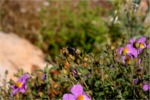 |
 |
 |
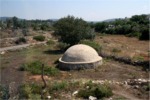 |
| Jeffrey, another photo nut. | A vista of the sea. | A Turkish grasshopper with odd markings. | Our transportation, comfortable with toilet and cold locker of water. As the water in Turkey is not trustworthy, we drank bottled water. | Tour Assistant Selçuk and our fearless bus driver. The bus has lucky number 111, and altan means red dawn/rising sun; hence, mazal tov, favorable star! | The top of a water cistern. |
|
|
|||||
| We enter Çamlik village. Shop sign. | Store and kitchen. | Rustic building. | A wall of stone. | Wood piles, for fencing and kindling. | Balcony staircase'. modern steel among the stone and wood. |
|
© |
|||||
| The minaret to the mosque. Nearby is the elementary school. | Inside the simple mosque. | Our village guide and Marina. | Stack of prayer rugs. | Entrance to the cistern. Rain water flows from the roof to storage inside. | A senior woman from the village. |
| The cemetery provides history. | An arbor gives shade.. | The village is filled with colorful blooms. | Fuchsias. | Pistachios. | A blaze of red. |
 |
 |
 |
 |
 |
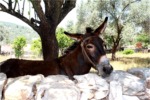 |
| Weaving demonstration #1. The village makes kilim rugs and various carpets. | Weaving demonstration #2 | The olive oil factory. | The camel pleases tourists. | Cooling off. | Donkey in the shade. |
 |
 |
 |
 |
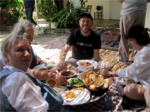 |
 |
| The cow avoids the sun. | And so do chickens. | We gather for lunch. | The food is delicious. I never tasted better garbanzos. | Others agree. [Marina's photo, edited] | The village band plays 9/8 folk tunes: 1-2-3/1-2-3/1-2/1-2. Paging Dave Brubeck. |
 |
 |
 |
 |
 |
 |
|
The absence of frets on this cümbüs makes it a banjo-oud. |
Violin and davul drum are the other instruments. |
The dancers rise to the occasion. [Joskun's photo, edited] |
As does a little charmer. [Joshun's photo, edited] |
Yuval and Joskun borrow the instruments. [Marina's photo, edited] |
Bodrum is a white city. |
 |
 |
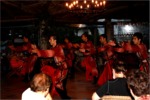 |
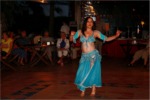 |
 |
|
|
Another hill of white buildings. |
Our hotel. |
A folk dance evening . . . |
. . . that closes, again, with a belly dancer. Front view. |
Back view. |
|
|
© 2011 Debra Jan Bibel |
|||||